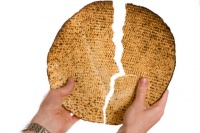Yachatz: Difference between revisions
From Halachipedia
No edit summary |
No edit summary |
||
| Line 11: | Line 11: | ||
[[Category:Pesach]] | [[Category:Pesach]] | ||
[[Category:Holidays]] | [[Category:Holidays]] | ||
{{Pesach}} | |||
Latest revision as of 17:56, 13 July 2023
- One should take the middle of the three matzot and split it in two. [1] One of those at the meal should put away (or hide) the larger piece of Matzah. We remove it from the table in order to perplex the children to ask the meaning behind this.[2] The Mishna Brurah[3] explains that if the children ask why we remove the matzot, the father should answer that we remove it to show that we can’t eat yet because we still have to tell the story of Yetziat Mitzrayim. The Be'er Hetev[4] writes that nowadays the common practice is not to remove the Seder Plate because the children know that the food on the Seder Plate is for show and not to be eaten.
- The minhag is to wrap the afikomin in some type of cloth based on the pasuk “משארותם צרורות על שמלותם” [5] that the Jews carried out the matzah out of Egypt in sacks on their shoulders.[6]
- Some have the minhag to place the afikomin on their shoulder as a remembrance to the Jews as they left Egypt.[7] The custom of Syrian Jews is to send it around the table and each participant in the Seder holds it with his right hand over his left shoulder and recites the passage of "Mish'arotam," to commemorate the way Benei Yisrael transported Matza out of Egypt.[8]
- Some have the minhag based on kabbalah to break the matzah into a daled and vav. [9]
Sources
- ↑ The Shulchan Arukh (473:6) writes that after karpas the head of household breaks the middle matzah into two parts. Some Rishonim, including the Smag (Asin #41), hold that one should break the top matzah based on the rule of ein ma’aviren al ha-mitzvot - not passing over a ready mitzvah. However, Rosh (Pesachim 10:30) and Tur (473:6) argue that one should break the middle matzah in order that the top one remains whole for the berakhah of hamotzei. The Shulchan Arukh (473:6) agrees with Rosh. It is noteworthy to include the opinion of Rambam (Hilkhot Chametz U-Matzah 8:6) who holds that one only needs two matzot with the bottom one being broken.
- ↑ S”A 473:6
- ↑ M"B 473:66
- ↑ Be'er Hetev 473:22
- ↑ Shemot 12:34
- ↑ S”A 473:6, Kitzur S”A 119:4, Nitei Gavriel (Pesach v. 2, p. 421)
- ↑ Kitzur S”A 119:3, Mishna Brurah 473:59
- ↑ Rabbi Eli Mansour
- ↑ Ben Ish Chai (Tzav #33), Nitai Gavriel (Pesach v. 2, p. 421)
